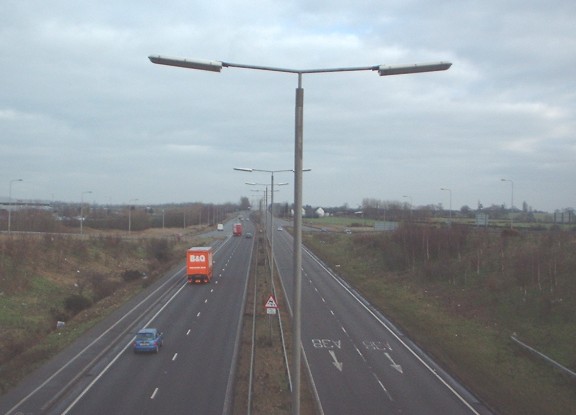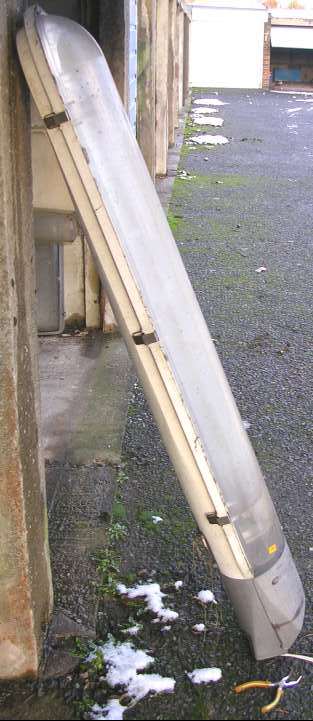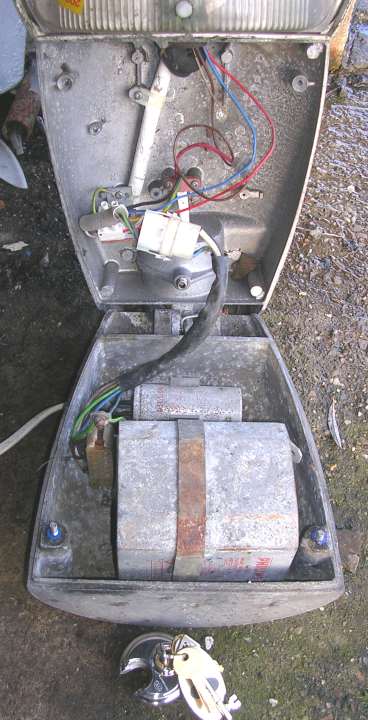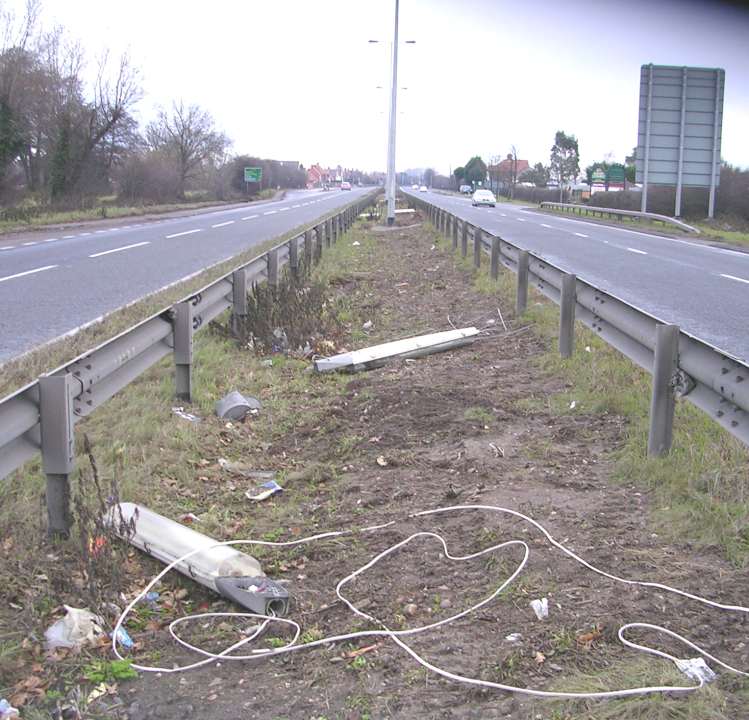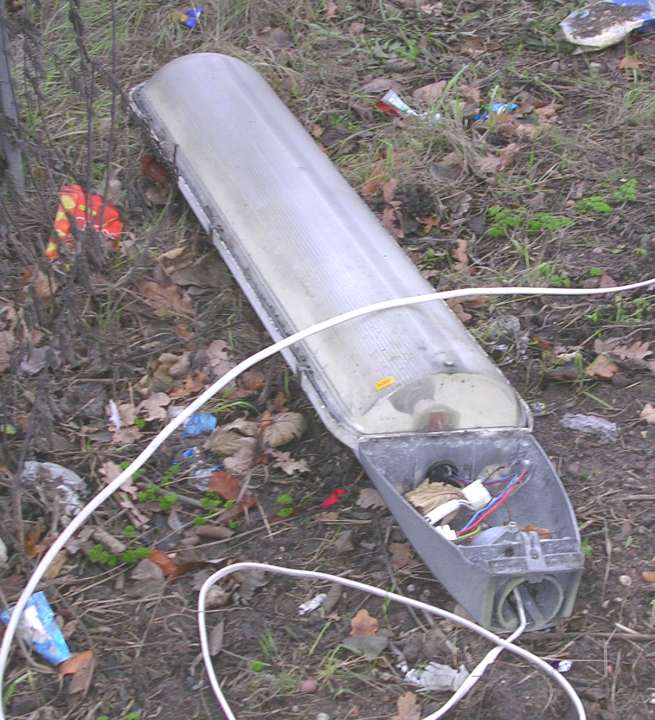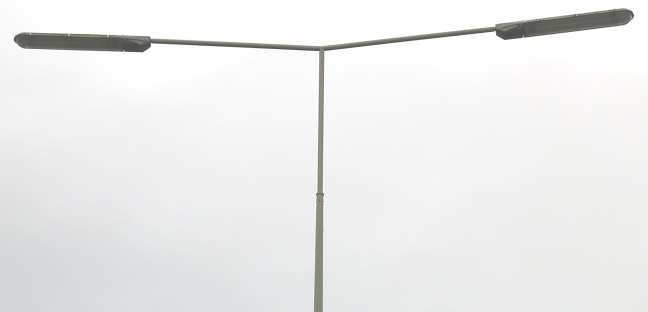180-watt SOX lanterns
|
Philips MA60 180-watt SOX lantern. Primarily for main road and motorway
use the Philips MA60 was the largest member of the MA range of lanterns
produced by Philips; MA meaning Main road lanterns. Like all lanterns in
the MA family, the MA60 has a fibreglass canopy and injection-moulded prismatic
bowl. Although still available from Philips, the MA range has been
re-designated as the SRS 201 range of lanterns by Philips, but remains more or
less unchanged in design. There are two main variants
of the MA60:
Both versions of the MA60
are represented in the collection. The MA60-OO remote-geared
version came from Walsall in the West Midlands in 2004, and was a victim of
Walsall Metropolitan Borough Council's PFI scheme. The lantern is thought to
have come from the Streetly District of Walsall and was the best example found
at the time of my visit to the Contractor's yard. Unfortunately its canopy is
quite tatty in appearance and the lantern will be replaced if a better example
is found. There are in fact two
'geared' MA60-GO's in the collection. The first is an unused example that came
from the City of Derby (my thanks to fellow collector Jeremy Strichley for
saving this superb lantern for me). The second example came off the A38 at
Fradley, Staffordshire, during November 2005, and was one of the hundreds of
MA60’s taken down on the section of the A38 running from Fradley in
Staffordshire through to Burnaston in Derbyshire. This SON for SOX lighting
renewal programme was part of a huge road improvement scheme that commenced in
2005, and was completed in 2006.
Remote-geared MA60-00's on twin-arm brackets in use on the
A38 in Derbyshire in early 2004. The picture shows what is now the last
remaining SOX lit section of the A38 between Fradley in Staffordshire and
Burnaston in Derbyshire.
The MA60-GO is a big lantern; the pliers give an idea of its size. The 'shoe' is the large aluminium casting at the bottom of the lantern. This example is the weather-beaten lantern from the A38. Sorry, no image of the MA60-OO remote-geared lantern in the collection is currently available The remote-geared MA60-OO has a cast-aluminium spigot receptor attached to the back end of the canopy, which fixes straight onto the lamppost bracket. The geared MA60-GO uses the same GRP canopy, but has a larger aluminium spigot fitting attached to it that also incorporates a large detachable ‘shoe’ containing the control-gear. The canopy and lens of the MA60 are also used for the integral-geared MA50-GO (SRS-201 135w) lantern, where the control-gear is mounted inside of the lantern itself. Access to the lamp on all models is made by releasing the seven stainless steel fasteners around the perimeter of the canopy (three of which also act as hinges), allowing the bowl to swing down clear of the canopy. Access to the control-gear is made by releasing the two recessed screws in the bottom section of the shoe; this allows the lower half of the shoe containing the control-gear to swing downward on a rear mounted quick-release hinge. The whole control-gear unit can be unplugged in one go and changed with a replacement unit to facilitate a quick repair to the lantern (see below).
Arrangement of the MA60-GO's control-gear inside this very oxidised 'shoe'. The shoe, which is hinged from the back, contains the large leak-transformer and capacitor. The disc lock and keys give an idea of scale. Redundant MA60s strewn along the central reservation of the A38 at Branston near Burton on Trent after their removal in December 2005. These lanterns would eventually be broken up into their component parts by the Contractors at their Nottingham depot; the SOX lamps being destroyed and the lantern remains skipped. The new Urbis ZX3 150w SON lantern replacements in the background were mounted onto new columns. A dumped Philips MA60-GO awaits its fate in late December 2005. All of these discarded lanterns had had their control-gear trays removed so that workmen could gain access to the spigot fixing screws to remove the lanterns from their brackets. The tiny yellow sticker on the bowl simply reads '2001', and probably means that the lantern was last overhauled in 2001 (?). The electric cable was left attached to some lanterns and was used as a means of quickly lowering the lantern to the ground after removal. Thanks to the kind offices of the Contractor a similar lantern from this contract has been saved for the collection.
MA60-GOs on a twin arm bracket on the A38 at Branston. When these lanterns were erected in the early 1990's, no account was taken of windage, which along with the combined weight of the geared MA60's would cause some of the longer twin-arm brackets to bow under the considerable weight. However, I don't ever recall seeing any failed brackets, or any fallen lanterns.
|
Copyright(c) 2005 Claire Pendrous. All rights reserved.
Please note that all pictures are by Claire Pendrous, or are part of the Claire Pendrous photographic collection unless otherwise stated; none of these images can be copied without obtaining prior permission.
